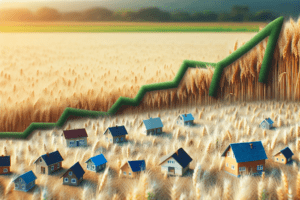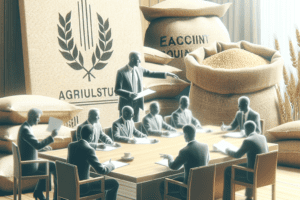The grain market in South America has been experiencing significant changes in recent years, driven by various factors including climate conditions, technological advancements, and global demand. This article delves into the current trends in the grain market across the continent, highlighting key players, production statistics, and the impact of international trade agreements.
Overview of Grain Production in South America
South America is one of the world’s leading regions for grain production, particularly known for its vast agricultural lands and favorable climate. The primary grains produced in this region include soybeans, corn, wheat, and rice. Brazil and Argentina are the two largest producers, contributing significantly to the global grain supply.
In recent years, Brazil has emerged as the world’s largest exporter of soybeans, surpassing the United States. This shift can be attributed to the country’s extensive investment in agricultural technology and infrastructure, which has allowed for increased yields and efficiency in production. Argentina, on the other hand, is renowned for its high-quality wheat and corn, making it a key player in the global grain market.
Key Factors Influencing Grain Production
Several factors influence grain production in South America, including:
- Climate Change: Variability in weather patterns has led to both challenges and opportunities for grain farmers. While some regions have experienced droughts, others have benefited from increased rainfall, allowing for more robust crop yields.
- Technological Advancements: The adoption of precision agriculture, genetically modified organisms (GMOs), and improved irrigation techniques has significantly enhanced productivity. Farmers are increasingly utilizing data analytics to optimize planting schedules and resource allocation.
- Government Policies: Agricultural policies and subsidies play a crucial role in shaping the grain market. Governments in South America have implemented various programs to support farmers, including financial assistance and research funding.
- Global Demand: The rising demand for grains, particularly from countries like China and India, has driven production levels higher. As populations grow and diets change, the need for grains continues to expand.
Market Trends and Future Outlook
The grain market in South America is currently witnessing several trends that are likely to shape its future. Understanding these trends is essential for stakeholders, including farmers, investors, and policymakers.
Increased Export Opportunities
With the growing global demand for grains, South American countries are well-positioned to capitalize on export opportunities. Brazil and Argentina have established themselves as key suppliers to international markets, particularly in Asia. The expansion of trade agreements, such as the Mercosur agreement, has further facilitated access to new markets.
Moreover, the ongoing trade tensions between major agricultural producers, such as the United States and China, have created openings for South American exporters. As countries seek alternative sources for grains, South America stands to benefit from its competitive pricing and quality.
Sustainability and Environmental Concerns
As the grain market grows, so do concerns about sustainability and environmental impact. The expansion of agricultural land for grain production has raised questions about deforestation, soil degradation, and water usage. In response, many farmers are adopting sustainable practices, such as crop rotation, cover cropping, and reduced pesticide use.
Consumer preferences are also shifting towards sustainably produced grains, prompting companies to invest in eco-friendly practices. This trend is likely to continue, influencing production methods and market dynamics in the coming years.
Technological Innovations
Technological innovations are transforming the grain industry in South America. The integration of artificial intelligence, machine learning, and blockchain technology is enhancing supply chain transparency and efficiency. Farmers are increasingly using drones and satellite imagery to monitor crop health and optimize resource use.
Furthermore, advancements in biotechnology are leading to the development of new grain varieties that are more resilient to climate change and pests. These innovations are crucial for maintaining productivity in the face of environmental challenges.
Challenges Facing the Grain Market
Despite the positive trends, the grain market in South America faces several challenges that could impact its growth and stability.
Climate Variability
Climate change poses a significant threat to grain production in South America. Extreme weather events, such as droughts and floods, can devastate crops and disrupt supply chains. Farmers must adapt to these changes by implementing more resilient agricultural practices and diversifying their crops.
Market Volatility
The grain market is subject to fluctuations in prices due to various factors, including global supply and demand dynamics, currency exchange rates, and geopolitical tensions. Farmers and exporters must navigate this volatility to ensure profitability and sustainability.
Infrastructure and Logistics
While South America has made strides in improving agricultural infrastructure, challenges remain. Inadequate transportation networks and storage facilities can hinder the efficient movement of grains from farms to markets. Investments in infrastructure are essential to support the growing grain industry and enhance competitiveness.
Conclusion
The grain market in South America is poised for growth, driven by increasing global demand, technological advancements, and favorable trade conditions. However, stakeholders must remain vigilant in addressing the challenges posed by climate change, market volatility, and infrastructure limitations. By embracing sustainable practices and leveraging innovation, South America can continue to be a key player in the global grain market, ensuring food security for future generations.













